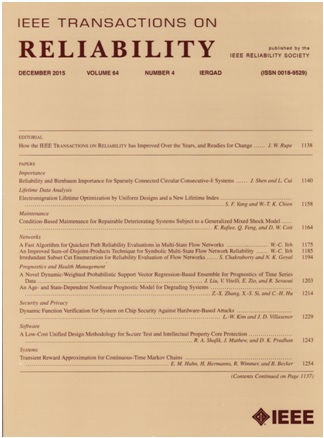具有特征生成和融合的半监督运行状况索引监控
IF 5.7
2区 计算机科学
Q1 COMPUTER SCIENCE, HARDWARE & ARCHITECTURE
引用次数: 0
摘要
健康指数(HI)对于评估系统健康状况至关重要,对于诸如异常检测和安全关键系统的剩余使用寿命预测等任务非常重要。实时、细致地监测系统状况至关重要,特别是在制造高质量和安全关键部件(如喷涂)时。然而,在实际场景中获取准确的健康状态信息(HI标签)可能是困难的或昂贵的,因为它需要连续的、精确的测量来完全捕获系统的健康状况。因此,使用从系统运行到故障的数据集(仅在健康和生命周期结束阶段提供有限的HI标签)成为一种实用的方法。我们采用深度半监督异常检测(DeepSAD)嵌入来解决提取与系统健康状态相关的特征的挑战,此外,我们引入了多样性损失来进一步丰富DeepSAD嵌入。我们还提出了一种具有等压约束的交替投影算法,将嵌入变换为具有递增趋势的归一化HI。在PHME2010铣削数据集(一个公认的具有地面真值HIs的基准)上进行验证,证实了我们提出的HIs估计的有效性。我们的方法进一步应用于使用高频电压监测热喷涂涂层的磨损状态。我们的贡献促进了更容易获得和可靠的HI估计,特别是在不可能获得地面真值HI标签的情况下。本文章由计算机程序翻译,如有差异,请以英文原文为准。
Semisupervised Health Index Monitoring With Feature Generation and Fusion
The health index (HI) is crucial for evaluating system health, important for tasks, such as anomaly detection and remaining useful life prediction of safety-critical systems. Real-time, meticulous monitoring of system conditions is essential, especially in manufacturing high-quality and safety-critical components, such as spray coating. However, acquiring accurate health status information (HI labels) in real scenarios can be difficult or costly because it requires continuous, precise measurements that fully capture the system's health. As a result, using datasets from systems run-to-failure, which provide limited HI labels at just the healthy and end-of-life phases, becomes a practical approach. We employ the deep semisupervised anomaly detection (DeepSAD) embeddings to tackle the challenge of extracting features associated with the system's health state In addition, we introduce a diversity loss to further enrich the DeepSAD embeddings. We also propose applying an alternating projection algorithm with isotonic constraints to transform the embedding into a normalized HI with an increasing trend. Validation on the PHME2010 milling dataset, a recognized benchmark with ground truth HIs, confirms the efficacy of our proposed HIs estimations. Our methodology is further applied to monitor wear states of thermal spray coatings using high-frequency voltage. Our contributions facilitate more accessible and reliable HI estimation, particularly in scenarios where obtaining ground truth HI labels is impossible.
求助全文
通过发布文献求助,成功后即可免费获取论文全文。
去求助
来源期刊

IEEE Transactions on Reliability
工程技术-工程:电子与电气
CiteScore
12.20
自引率
8.50%
发文量
153
审稿时长
7.5 months
期刊介绍:
IEEE Transactions on Reliability is a refereed journal for the reliability and allied disciplines including, but not limited to, maintainability, physics of failure, life testing, prognostics, design and manufacture for reliability, reliability for systems of systems, network availability, mission success, warranty, safety, and various measures of effectiveness. Topics eligible for publication range from hardware to software, from materials to systems, from consumer and industrial devices to manufacturing plants, from individual items to networks, from techniques for making things better to ways of predicting and measuring behavior in the field. As an engineering subject that supports new and existing technologies, we constantly expand into new areas of the assurance sciences.
 求助内容:
求助内容: 应助结果提醒方式:
应助结果提醒方式:


